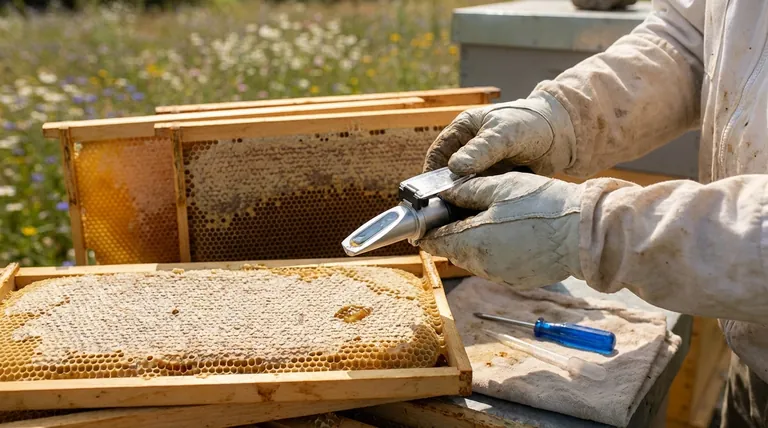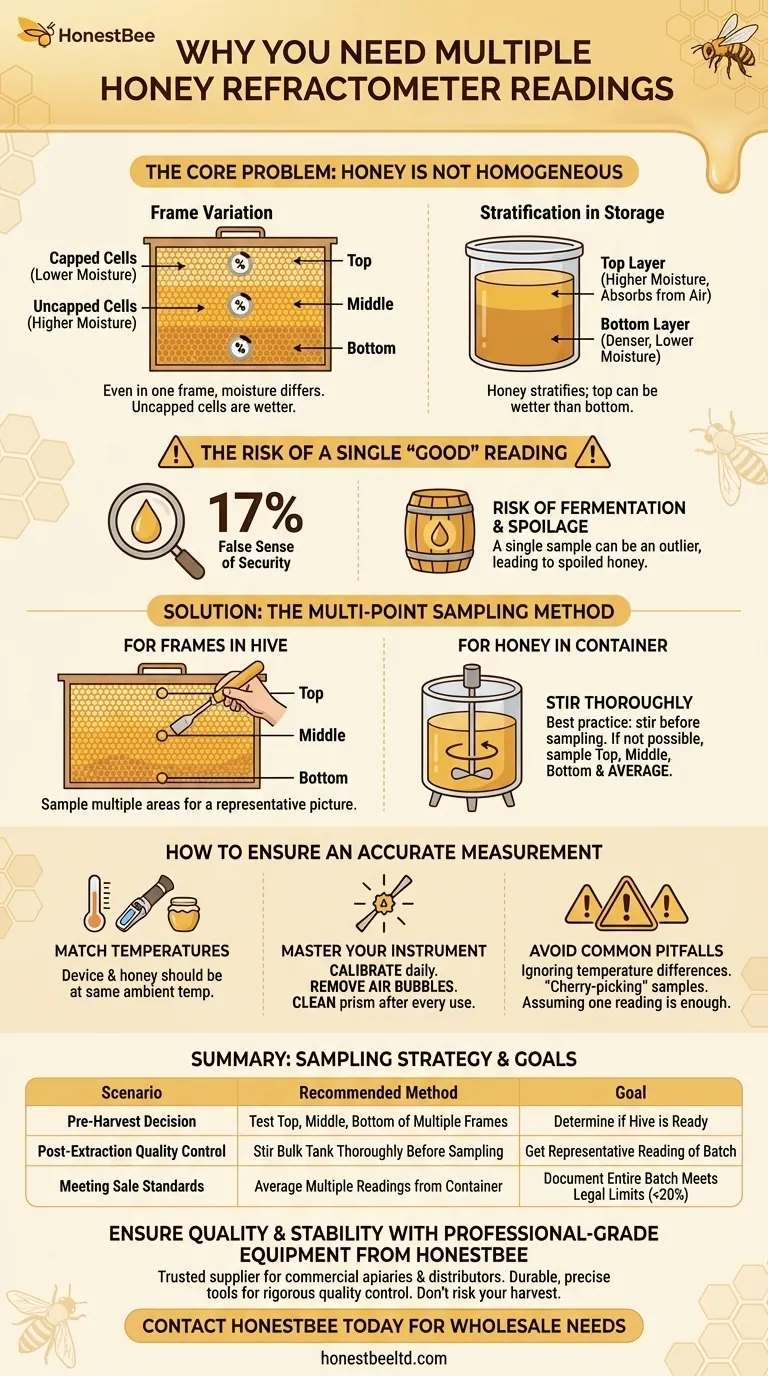At its core, taking multiple readings with a honey refractometer is recommended because the moisture content within a single batch of honey is rarely uniform. Whether the honey is in a frame or a storage container, moisture levels can vary significantly from one spot to another. Averaging several readings from different locations provides a far more accurate and reliable measurement of the overall batch, preventing the false security a single, potentially unrepresentative reading might give.
A single measurement tells you the moisture content of a single drop; multiple, averaged measurements tell you the true condition of your entire harvest. This practice is the difference between hoping your honey is stable and knowing it is.

The Core Problem: Honey is Not Homogeneous
The primary reason for multiple tests is that honey is a natural, variable product. A single reading can easily be misleading.
Variation Within the Hive
Even in a single frame, honey doesn't cure at a perfectly even rate. Moisture content can differ between the top, middle, and bottom of the frame.
Honey in uncapped cells will almost always have a higher moisture content than honey in fully capped cells, where the bees have deemed it ready for long-term storage.
Stratification in Storage
Once extracted and placed in a bucket or tank, honey can stratify. The top layer can absorb moisture from the atmosphere, making it wetter than the denser honey that settles at the bottom.
If you only test the top layer, you might discard or downgrade perfectly good honey. If you only test the bottom, you might bottle honey with a top layer that is prone to fermentation.
The Risk of a Single "Good" Reading
A single sample can easily be an outlier. You might happen to test a perfectly cured drop from a capped cell, giving you a reading of 17%, while surrounding uncapped cells are at 20% or higher.
This creates a false sense of security, leading you to harvest or bottle a batch that is at high risk of fermenting and spoiling.
How to Ensure an Accurate Measurement
Achieving a trustworthy result requires a methodical process that accounts for honey's inherent variability.
The Multi-Point Sampling Method
For frames in the hive, use a clean tool to pull samples from several different areas. Test honey from the top, middle, and bottom of the frame to get a representative picture.
For honey in a container, the best practice is to stir the honey thoroughly before taking a sample. If stirring isn't possible, take samples from the top, middle, and bottom of the container and average the results.
Match Your Temperatures
For an accurate reading, the refractometer and the honey sample should be at the same ambient temperature. A significant temperature difference between the device and the honey will skew the results.
Master Your Instrument
Proper technique is just as important as the sampling method. Always calibrate your refractometer before the first use of the day.
When applying the sample, use just enough honey to cover the prism and gently wiggle the cover plate to remove any air bubbles, which can interfere with the reading.
Finally, clean the prism with a soft, damp cloth after every single use. Dried honey residue will make subsequent readings inaccurate.
Understanding the Common Pitfalls
Avoiding common mistakes is critical for obtaining data you can trust.
Ignoring Temperature Differences
Testing warm honey from the hive on a cool refractometer (or vice-versa) is a primary source of error. Allow your equipment to acclimate to the ambient temperature where you are testing.
"Cherry-Picking" Your Sample
It's tempting to take a sample from the most beautifully capped section of a frame. This bias leads to overly optimistic readings that don't reflect the reality of the whole frame, which may include uncapped, high-moisture areas.
Assuming a Single Reading is "Good Enough"
The most dangerous pitfall is complacency. Trusting a single reading, no matter how good it seems, ignores the fundamental nature of honey. The risk of fermentation is too high to rely on a single data point.
How to Apply This to Your Goal
Your testing strategy should align with your specific objective.
- If your primary focus is deciding when to harvest: Take multiple readings from different locations across several frames in your super. This average tells you if the hive as a whole is ready.
- If your primary focus is post-extraction quality control: Thoroughly stir your bulk storage tank before taking a sample for a definitive, representative reading of the entire batch.
- If your primary focus is meeting legal or sale standards: Document a process of taking multiple, averaged readings to prove your entire batch is below the legal moisture limit (typically under 20% for most raw honey).
Ultimately, a rigorous and repeatable measurement process is your best tool for guaranteeing the quality, stability, and value of your honey.
Summary Table:
| Scenario | Recommended Sampling Method | Goal |
|---|---|---|
| Pre-Harvest Decision | Test honey from top, middle, and bottom of multiple frames. | Determine if the entire hive is ready for harvest. |
| Post-Extraction Quality Control | Stir the bulk tank thoroughly before taking a sample. | Get a representative reading of the entire batch. |
| Meeting Sale Standards | Take and average multiple readings from the container. | Document that the entire batch meets legal moisture limits (e.g., <20%). |
Ensure the quality and stability of every batch with professional-grade equipment from HONESTBEE.
As a trusted supplier to commercial apiaries and beekeeping equipment distributors, we provide the durable, precise tools you need for rigorous quality control. Don't let inaccurate moisture readings risk your harvest.
Contact HONESTBEE today to discuss your wholesale needs and equip your operation for success.
Visual Guide

Related Products
- Precision Honey Refractometer Instrument for Quality Assessment
- Professional Thermostatic Conical Honey Melter
- High Quality Honey Dehumidifier Dryer Thickening Machine for Beekeeping
- Premium Diamond-Faceted Glass Honey Dispenser
- Modern Honeycomb Pattern Wooden Honey Dipper for Stirring and Drizzling
People Also Ask
- Why is a honey refractometer considered essential for commercial beekeepers? Ensure Honey Quality and Profitability
- What are the key steps to using a honey refractometer? Ensure Honey Quality & Prevent Fermentation
- What are the features of the Standard Refractometer for honey moisture content? Essential Tools for Quality Control
- What are the benefits of using a Pocket Digital Honey Refractometer? Achieve Precision & Speed in Honey Quality Control
- What is a honey refractometer? The Essential Tool for Perfect Honey Quality



















